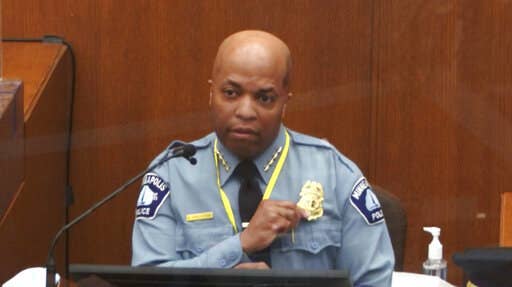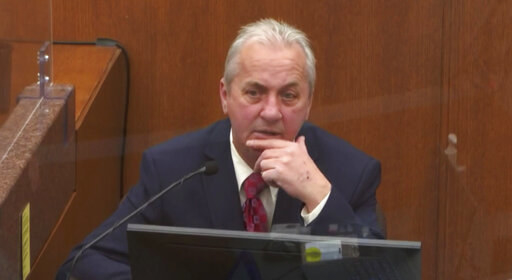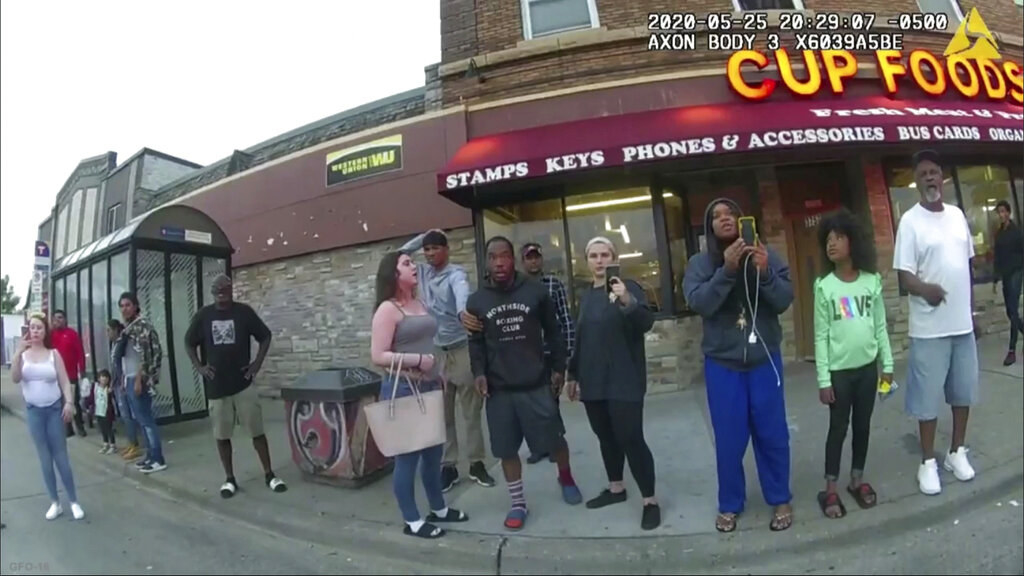
Top-ranking police officials from the Minneapolis Police Department, including the city’s police chief, have testified that former officer Derek Chauvin’s use of force against George Floyd was unnecessary and violated policy and training protocols.
In a rare occurrence of police officers going against one of their own, Police Chief Medaria Arradondo, Lt. Richard Zimmerman, and Chauvin’s now-retired former supervisor, Sgt. David Pleoger, testified against him during his murder trial in the killing of Floyd.
Arradondo, who joined the department in 1989 and steadily rose through the ranks to become the city’s first Black police chief three years ago, gave damaging testimony against the former officer on Monday, saying he “vehemently disagreed” with Chauvin’s use of force against Floyd during his arrest on May 25, 2020.
“There’s an initial reasonableness in trying to get him under control in the first few seconds,” Arradondo told the jury. “But once there was no longer any resistance — and clearly when Mr. Floyd was no longer responsive and even motionless — to continue to apply that level of force to a person prone down, handcuffed behind their back … that in no way, shape, or form is part of our policy, is not part of our training, and is not part of our ethics and values.”
Chauvin’s defense strategy is that Floyd’s use of drugs and underlying medical conditions contributed to his death and that the officer's actions were consistent with police training and policies.
However, Arradando told the court that Chauvin’s action of pressing his knee on Floyd’s neck for 9 minutes and 29 seconds “absolutely” violated the department's use-of-force policy and went against its “ethics and values.”
“That is not part of our policy,” Arradando told the jury when shown the now-viral image of Chauvin looking up while putting Floyd in a knee chokehold. “That is not what we teach.”

Arradando said that Chauvin’s actions did not constitute “objectively reasonable force” and that the neck restraint he used on Floyd was not taught to officers as part of their training.
“When I look at this image and when I look at the facial expression of Mr. Floyd, that does not appear in any way, shape, or form that is light to moderate pressure,” Arradondo testified in court.
Another high-ranking police official, Inspector Katie Blackwell, who until recently was the commander of the department's training division, also testified that Chauvin’s neck restraint was not consistent with police training.
“I don’t know what kind of improvised position this is,” she said referring to Chauvin putting his knee on Floyd’s neck. “This is not what we train.”
The police chief said Chauvin should have stopped restraining Floyd as soon as he had stopped resisting and “certainly once when he was in distress and trying to verbalize.”
Videos showed Floyd crying out multiple times that he could not breathe and that he was going to die. Several bystanders testified last week about seeing Floyd become unconscious and “limp” as Chauvin continued to dig his knee into his neck.
According to Arradondo, Chauvin also violated department policies by not rendering medical aid to Floyd when officers could not find a pulse as well by failing to deescalate the situation.
“That action is not deescalation,” Arradondo said. “When we talk about our framework of the sanctity of life and the principles and values of life, that action goes contrary to what we’re talking about.”
His statements echoed what two other department officials testified as witnesses for the prosecution last week.
Zimmerman, the head of the department's homicide division and the most senior officer on the force, testified on Friday that the force Chauvin used on Floyd was "totally unnecessary" and “uncalled for.”
He said that in more than 30 years of training at the department, he had never been trained to press his knee against the neck of a subject to restrain him.
“That would be considered top-tier deadly force because of the fact that if you kneel on a person’s neck that can kill him,” Zimmerman told the jury.

Zimmerman, who responded to the scene hours after Floyd had been transported to the hospital, said Chauvin’s action of using his knee to crush his neck for so long went too far.
"First of all, pulling [Floyd] down to the ground facedown and putting your knee on the neck for that amount of time is just uncalled for,” Zimmerman said. “I saw no reason why the officers felt they were in danger, if that’s what they felt, and that’s what they would have to feel to be able to use that kind of force.”
Like Arradondo, Zimmerman testified that Chauvin should have ended his restraint of Floyd once he was handcuffed and lying prone on the ground.
Chauvin’s former supervisor, Pleoger, also testified last week that officers should have “ended the restraint” when Floyd was “no longer offering any resistance to the officers."
Citing department training, both Arradondo and Zimmerman said that officers should move subjects who are handcuffed in the prone position to their side or have them sit up “as soon as possible” to avoid the danger of constricting their breathing or what is known as “positional asphyxia.”
Both the veteran cops said that department officers are obligated to provide medical assistance to a distressed subject in custody even after they have called an ambulance and even while they are using defensive tactics against the subject.
“They’re still in our custody, and they have rights and the humanity of this profession. We need to make sure we’re protecting them,” Arradondo said.
Multiple witnesses testified that apart from checking Floyd’s pulse, the four officers involved in his arrest did not provide any medical aid to him after he appeared to be unresponsive and motionless. Chauvin continued to press his knee on Floyd’s neck even after the ambulance arrived and while a paramedic checked for his pulse, according to videos and witnesses’ testimonies.
An emergency care doctor who pronounced Floyd dead at the hospital testified Monday that for every minute a patient in cardiac arrest does not receive CPR, their chance of survival decreases by 10% to 15%. He said Floyd had been in cardiac arrest for at least 30 minutes before he arrived at the hospital.
In his cross-examination of the Minneapolis Police Department officials, Chauvin’s attorney, Eric Nelson, asked them about whether an increasingly “hostile” crowd of bystanders that was growing bigger and angrier at the officers’ actions would affect their decisions on the use of force and deescalation.

Zimmerman testified that the bystanders who witnessed Floyd take his last breaths under the weight of Chauvin’s knee did not appear to be “an uncontrollable threat” to the officers at the scene.
He said the crowd should not have an effect on officers’ actions “as long as they’re not attacking” the officers.
Arradondo said that, per department policy, bystanders were allowed to express their First Amendment rights and record officers’ actions but not “physically” obstruct them. He agreed that one way to deescalate a crow experiencing something shocking would be for the officers to stop doing the thing that’s shocking to them.
During his testimony, the police chief emphasized the “sanctity of life” being the most important aspect when officers use force against people.
“Of all the things we do as police officers for the Minneapolis Police Department, the thousands of calls we respond to, it is my firm belief that one single incident we will forever be judged on will be our use of force,” Arradando said. “While it is absolutely imperative that our officers go home at the end of their shift, we want to make sure our community members do too.”
